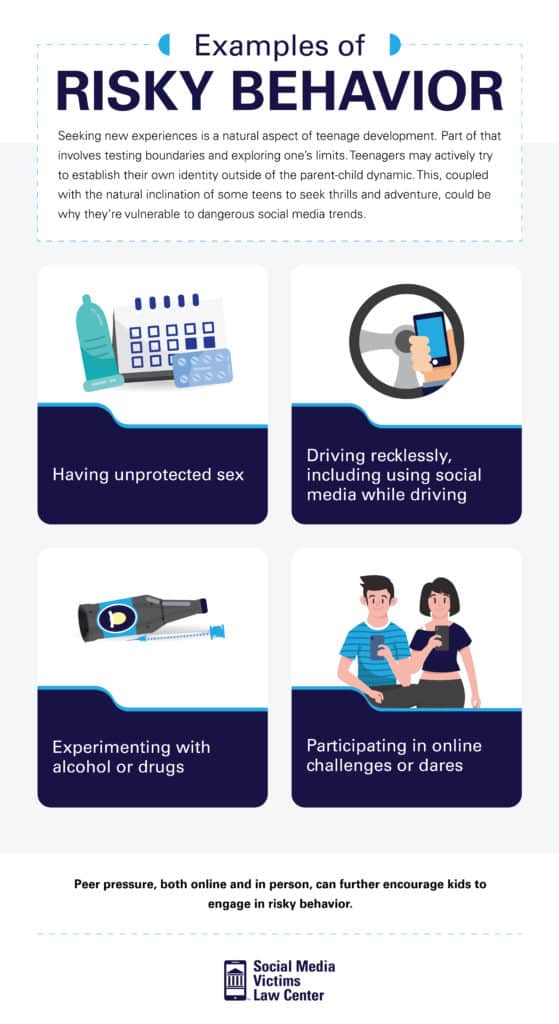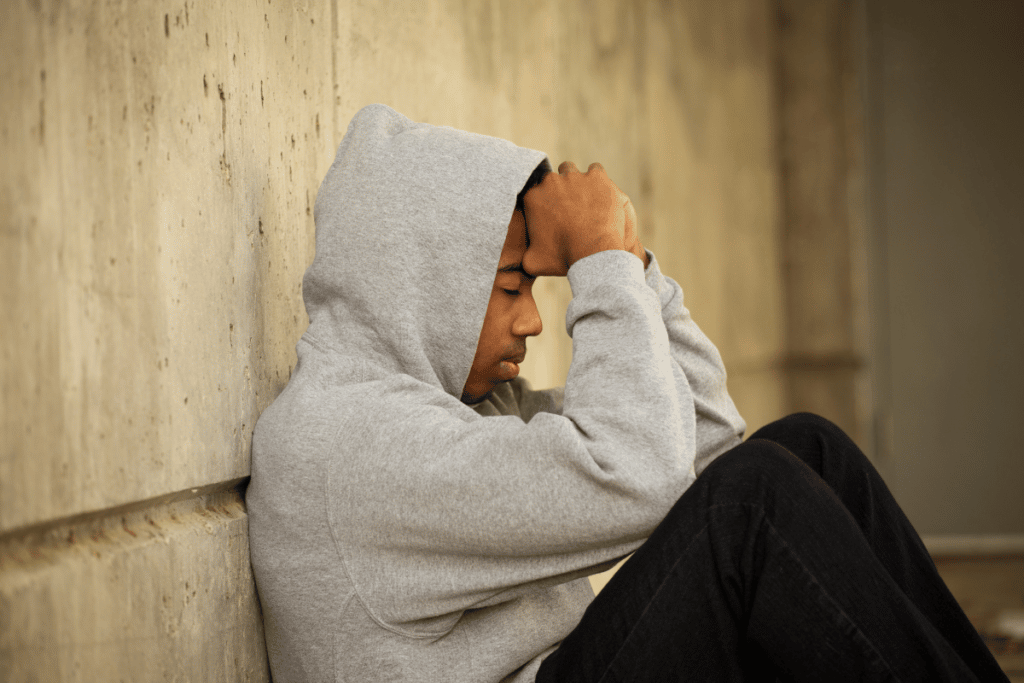Social Media and Risky Behavior
Teens and pre-teens tend to engage in risky behavior associated with social media and internet trends. Adolescent development can make it harder for these age groups to perceive risk. As a parent, you may be able to help reduce problematic internet usage.
 Written and edited by our team of expert legal content writers and reviewed and approved by Attorney Matthew Bergman
Written and edited by our team of expert legal content writers and reviewed and approved by Attorney Matthew Bergman
- Content last updated on:
- June 12, 2025
Written and edited by our team of expert legal content writers and reviewed and approved by

- Content last updated on:
- June 12, 2025
Kids will be kids. They may make bad decisions, get into unsafe situations, and act out as they grow up. In fact, until the age of 25, a person’s brain is still growing. The frontal lobe, the part of the brain responsible for higher-level thinking, decision-making, and evaluating the consequences of risky behavior, is the last part of the brain to develop fully.
With the internet and social media rise comes a seemingly never-ending supply of risky behavior for tweens and teens to engage in. An article published by JMIR Pediatrics and Parenting explains how some of the most-used social media platforms originated when today’s adolescents were infants. This type of technology has essentially been woven into their developmental experience.
How can you protect your child from the pitfalls of social media as a parent?
Understanding Adolescent Development
As adolescents start to develop reasoning and a sense of self, they actively try to forge their own identities and form attachments with people other than their parents. This period is often stressful for children since it involves new emotions and the need to develop social relationships and increase their sense of independence and responsibility.
Part of adolescent development is the need to create an independent identity, but tweens and teens are also driven by an intense desire to fit in and have peer approval. Many experts agree that the need to belong is a fundamental human motive and a drive to create and maintain interpersonal relationships.
This may involve behaving in a way that conforms to group acceptance or feeling the need to impress their group by showing off or performing to maintain approval.
Popularity on social media, measured by friends, followers, likes, and shares, is the modern iteration of belonging to a clique. Now, your teen can have a sense of belonging to a larger group of people through social media platforms.
Adverse Childhood = Increased Risky Behavior
The Adverse Childhood Experiences (ACE) study conducted by the Centers for Disease Control and Prevention (CDC) found that childhood exposure to various situations can act as a catalyst for a child to engage in risky behavior in adolescence. These include:
- Abuse and neglect
- Community or domestic violence
- Familial mental illness or substance abuse
- Instability due to parent separation
Adolescents who faced adverse childhoods are at a higher risk for substance abuse, depression, teenage pregnancy, and suicide.
Approximately 61% of adults have reported experiencing at least one type of ACE by the age of 18. The stress induced by these circumstances can affect brain development, immune system function, and stress-response systems. Furthermore, a child’s decision-making and attention can be affected.

Examples of Risky Behavior in Adolescents
Many factors play into the “why” of risky behavior in adolescents. In addition to brain development and the need for self-identity and belonging, peer pressure and external stresses can further encourage kids to engage in risky behavior.
Some of the most common types of risky behavior include:
- Driving recklessly i.e. texting, driving under the influence
- Having unprotected sex
- Experimenting with alcohol or drugs
- Not wearing helmets or seatbelts
- Engaging in illegal activities like trespassing or vandalism
How Social Media Influences Risky Behavior
The “Satanic Panic” and villainization of heavy metal music in the 1980s. The internet urban legend “Slenderman” case in the early 2010s. Outside influences have long been factors in how adolescents conduct themselves.
Social media continues this phenomenon in today’s society. A Pew Research Center survey of 750 people aged 13 to 17-years-old found that 97 percent use a social media platform, such as Instagram, TikTok, Snapchat, or YouTube.
Exactly how much of an impact does social media have on a child’s risky behavior?
Peer Approval
Facebook likes. Instagram favorites. Twitter follows. The ability to quantify peer approval through social media is an instigator and encourager for tweens and teens to engage in risky behavior. It also impacts self-perception and acceptance.
A literature review published in the Journal of Pediatric and Adolescent Gynecology found that bold and daring behavior is rewarded with attention on social media. This response motivates adolescents to continue with the behavior by posting photos or videos to impress their peers.
Furthermore, it found that 54 percent of social media profiles referenced at least one high-risk behavior involving substance abuse, violence, and unprotected sexual activity. These types of behaviors can be perceived as exciting or forbidden, which is why those who engage in them are often applauded.
Making a risky decision based on acceptance is commonplace in today’s youth. Research in Technology and Adolescent Health showed that peers can increase a person’s willingness to engage in risky behavior.
One example is an 18-year-old who died in a car accident while using Snapchat. The social platform offers countless filter options, with one being a speedometer that shares how fast a person is driving. The victim had been sending a Snapchat video to his friends using this filter. The family claims the platform “planted the seed” and hopes to inform others of the risks of adolescents using these addictive apps. Snapchat removed the filter in 2021 amid allgetions of it promoting reckless driving.
Internet Trends
Social media challenges directly play into an adolescent’s risky behavior tendencies. Teens are drawn to behavior that attracts attention, especially on social media, which is why internet trends and social media challenges seemingly go viral so quickly.
However, teens don’t consider the danger, harm, or ramifications of partaking in some of these challenges. Adolescents tend to only focus on the social media rewards of this type of behavior.
Examples of unsafe challenges that quickly gained popularity include:
- Tide pod challenge
- “Blackout” challenge
- Benadryl challenge
- Cooking chicken in NyQuil
Aggressive Behavior
Research indicates a correlation between the number of hours spent on social media and an increased level of aggressive behavior. For example, adolescents who have committed violent crimes were found to view violent content online more than adolescents who didn’t commit serious crimes.
The amount of internet use may not be the only cause of criminal or violent behavior. The quality of a teen’s online experience may also contribute to their propensity to exhibit violent or risky behavior.
Several studies have concluded that internet addiction (IA) and problematic internet use (PIU) are linked to increased aggression. These two conditions are defined as internet usage that is:
- Markedly distressing
- Uncontrollable by the individual
- Creating problems with school or work obligations
- Leading to financial difficulties, such as keeping a job
If you notice a drop in grades, disinterest in offline activities, or resistance to participating in extracurricular activities or a part-time job, it may be time to examine your teen’s internet usage and how much time they spend online.

The Impact of Risk Behavior on Emotional Well-Being for Teens
A study published in JAMA Network found that adolescents who used social media for more than three hours a day could have a higher risk of developing mental health problems. The study consisted of over 6,500 people aged 12 to 15-years-old.
Other studies have observed connections between social media use and anxiety, depression, and poor sleep quality.
Even normal use of social media, such as scrolling through Instagram or Facebook, may have long-term consequences for a teen’s mental health and lead to a decline in an individual’s well-being. Using social media also opens a person up to being blackmailed, cyberbullied, or harrassed.
According to Brain Imaging and Behavior, adolescents with PIU may also be prone to comorbid mental health conditions, such as depressive symptoms and alcohol use.
This could be due to brain structure abnormalities in which the reward circuitry is affected by internet use. Adolescents with internet addiction or PIU may abuse alcohol at higher rates than their peers without IA and PIU.
Frequently Asked Questions
What social media apps do teens use most?
A 2022 study done by Pew Research Center found that YouTube is the most used social media platform for teens. TikTok, Instagram, and Snapchat follow suit in popularity.
What is inappropriate behavior on social media?
Various behaviors can be considered inappropriate for adolescents:
- Embarrassing others by posting pictures or revealing personal information
- Posting mean or threatening comments or messages
- Spreading rumors
- Promoting violence or sexually explicit content
- Advocating unsafe behavior
What are risky uses of social media?
Social media can be useful and beneficial for teens and pre-teens. However, there are inherent risks involved:
- Uploading inappropriate content
- Sharing personal information with strangers
- Cyberbullying
- Cyberstalking
- Exposure to alcohol and drug use
- Exposure to targeted ads and marketing
- Exposure to inaccurate information
- Data breaches
A 2022 study found that, across 16 million posts on top social media platforms, alcohol and drug use was depicted positively. Evidence shows that exposure like this can cause teens to develop substance abuse issues.
Does social media encourage risky behavior?
Several studies support that broadcasting high-risk behavior and activities on social media platforms encourages adolescents to participate in the same or similar manner. The widespread visibility of these actions make them seem safe, normal, and easy to imitate.
Need help with your teen’s risky behavior?
As a parent, your first instinct may be to take away your teen’s computer and phone immediately. However, removing the internet isn’t going to remove a teen’s impulsivity or desire to engage in risky behavior; cutting the connection between your teen and their online communities may do more harm than good.
Instead, open a dialogue with your child about risky behavior and consequences. Be supportive and understanding. Ensure they understand the right kind of behavior to engage in.
The director of the Developmental Neuroscience Laboratory at the University of California at Los Angeles comments, “The first step in helping adolescents understand and use their developing brain more comfortably, creatively, and productively is to stop creating a narrative that pathologizes adolescents. Once we feel more comfortable and celebratory about the emerging sense of identity, agency, and self-reliance, so will adolescents.”
Additional ways you can help your pre-teen or teen:
- Set aside quality time with your child
- Get to know their friends and encourage face-to-face contact
- Take advantage of teachable moments
- Discuss safe use of social media and associated risks
- Set rules, boundaries, and expectations
It’s important to remember that children and teens are constantly learning, developing, and growing. As a parent, you can nurture that growth and direct them to rational thinking skills.
If your child has been hurt as a result of social media use, we can help. Contact Social Media Victims Law Center today to discuss your legal options.
Frequently Asked Questions
For individuals and children who have been
We only handle cases on a contingent fee basis. This means that we are paid a portion of any recovery obtained in the case and you do not owe us any attorneys’ fees if the lawsuit does not result in a recovery.
Every case is unique. Our attorneys will work with your family to evaluate your potential case and help you evaluate whether filing a lawsuit or other legal proceeding is in your family’s best interest. Generally speaking, the types of cases we handle involve serious mental health effects, including attempted or completed suicide, eating disorders, inpatient mental health treatment, or sexual trafficking/exploitation that was caused by or contributed to through addictive or problematic social media use by teens and young adults.
We are a law firm based near Seattle, WA comprised of lawyers who have spent their entire careers representing victims who have been harmed by dangerous products. We are also parents. Shocked and troubled by the recent revelations about the harm caused to teens and young adults by social media platforms, which powerful technology companies have designed to be highly addictive, Social Media Victims Law Center was launched specifically to help families and children who have suffered serious mental harm or exploitation through social media use to obtain justice.
